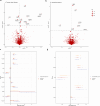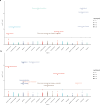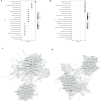Comprehensive mendelian randomization analysis of plasma proteomics to identify new therapeutic targets for the treatment of coronary heart disease and myocardial infarction
- PMID: 38689297
- PMCID: PMC11061979
- DOI: 10.1186/s12967-024-05178-8
Comprehensive mendelian randomization analysis of plasma proteomics to identify new therapeutic targets for the treatment of coronary heart disease and myocardial infarction
Abstract
Background: Ischemic heart disease is one of the leading causes of mortality worldwide, and thus calls for development of more effective therapeutic strategies. This study aimed to identify potential therapeutic targets for coronary heart disease (CHD) and myocardial infarction (MI) by investigating the causal relationship between plasma proteins and these conditions.
Methods: A two-sample Mendelian randomization (MR) study was performed to evaluate more than 1600 plasma proteins for their causal associations with CHD and MI. The MR findings were further confirmed through Bayesian colocalization, Summary-data-based Mendelian Randomization (SMR), and Transcriptome-Wide Association Studies (TWAS) analyses. Further analyses, including enrichment analysis, single-cell analysis, MR analysis of cardiovascular risk factors, phenome-wide Mendelian Randomization (Phe-MR), and protein-protein interaction (PPI) network construction were conducted to verify the roles of selected causal proteins.
Results: Thirteen proteins were causally associated with CHD, seven of which were also causal for MI. Among them, FES and PCSK9 were causal proteins for both diseases as determined by several analytical methods. PCSK9 was a risk factor of CHD (OR = 1.25, 95% CI: 1.13-1.38, P = 7.47E-06) and MI (OR = 1.36, 95% CI: 1.21-1.54, P = 2.30E-07), whereas FES was protective against CHD (OR = 0.68, 95% CI: 0.59-0.79, P = 6.40E-07) and MI (OR = 0.65, 95% CI: 0.54-0.77, P = 5.38E-07). Further validation through enrichment and single-cell analysis confirmed the causal effects of these proteins. Moreover, MR analysis of cardiovascular risk factors, Phe-MR, and PPI network provided insights into the potential drug development based on the proteins.
Conclusions: This study investigated the causal pathways associated with CHD and MI, highlighting the protective and risk roles of FES and PCSK9, respectively. FES. Specifically, the results showed that these proteins are promising therapeutic targets for future drug development.
Keywords: Biomarker; Coronary heart disease; Drug target; Myocardial infarction; Protein; Proteome-wide mendelian randomization.
© 2024. The Author(s).
Conflict of interest statement
The authors declare no competing interests.
Figures






Similar articles
-
Proteome-wide mendelian randomization investigates potential associations in heart failure and its etiology: emphasis on PCSK9.BMC Med Genomics. 2024 Feb 21;17(1):59. doi: 10.1186/s12920-024-01826-6. BMC Med Genomics. 2024. PMID: 38383373 Free PMC article.
-
Sex-specific effect of serum urate levels on coronary heart disease and myocardial infarction prevention: A Mendelian randomization study.Nutr Metab Cardiovasc Dis. 2022 May;32(5):1266-1274. doi: 10.1016/j.numecd.2022.01.022. Epub 2022 Jan 22. Nutr Metab Cardiovasc Dis. 2022. PMID: 35197211
-
Mendelian randomization evaluation of causal effects of fibrinogen on incident coronary heart disease.PLoS One. 2019 May 10;14(5):e0216222. doi: 10.1371/journal.pone.0216222. eCollection 2019. PLoS One. 2019. PMID: 31075152 Free PMC article.
-
Causal Effect of Plasminogen Activator Inhibitor Type 1 on Coronary Heart Disease.J Am Heart Assoc. 2017 May 26;6(6):e004918. doi: 10.1161/JAHA.116.004918. J Am Heart Assoc. 2017. PMID: 28550093 Free PMC article. Review.
-
Genetics of coronary heart disease: towards causal mechanisms, novel drug targets and more personalized prevention.J Intern Med. 2015 Nov;278(5):433-46. doi: 10.1111/joim.12407. J Intern Med. 2015. PMID: 26477595 Review.
Cited by
-
Application of large-scale and multicohort plasma proteomics data to discover novel causal proteins in gastric cancer.Discov Oncol. 2024 Oct 18;15(1):570. doi: 10.1007/s12672-024-01460-9. Discov Oncol. 2024. PMID: 39422802 Free PMC article.
-
Unveiling causal relationships between addiction phenotypes and inflammatory cytokines: insights from bidirectional mendelian randomization and bibliometric analysis.Eur Arch Psychiatry Clin Neurosci. 2024 Sep 26. doi: 10.1007/s00406-024-01915-8. Online ahead of print. Eur Arch Psychiatry Clin Neurosci. 2024. PMID: 39327304
References
Publication types
MeSH terms
Substances
Grants and funding
LinkOut - more resources
Full Text Sources
Medical
Miscellaneous

